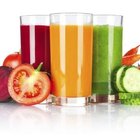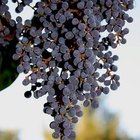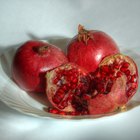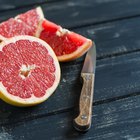
Even without any added sugar, cranberry juice is still high in natural sugar, despite its tart taste. This doesn't mean you have to avoid cranberry juice, however, as the American Diabetes Association recommends 100 percent fruit juice without added sugar -- but it does mean you’ll need to keep track of how much you drink and include its sugar as part of your daily carbohydrate intake. On the positive side, cranberry juice is a rich source of phytonutrients and vitamins C and E.
Natural Sugar
Different types of fruit juice are often mixed with cranberry juice to give it a touch of sweetness without adding sugar. Whether you prefer straight cranberry juice or a cranberry juice cocktail, be sure it's made from 100 percent pure fruit juice. If the label isn't clear, check the list of ingredients for the presence of sugar, honey or sweeteners such as high fructose corn syrup. You may find it hard to believe because cranberries are so tart, but a 1-cup serving of unsweetened cranberry juice contains nearly 31 grams of natural sugar. This amount provides 24 percent of your recommended carbohydrates for an entire day.
Antioxidant Vitamins
Two good reasons to enjoy unsweetened cranberry juice come in the form of vitamins C and E, which are both antioxidants that neutralize free radicals before they can damage healthy cells. For example, both vitamins protect your skin from free radicals formed in response to sunlight. Your body needs vitamin C to make a special protein -- collagen -- that gives your skin strength and supports your muscles. One cup of unsweetened cranberry juice supplies 20 percent of your recommended daily allowance of vitamin E and 31 percent of your daily vitamin C.
Phytonutrients
Cranberry juice is naturally packed with a variety of healthy phytonutrients that also work as antioxidants and show promise for preventing certain types of cancer, according to a review published in the "Journal of Nutrition" in 2007. When women drink cranberry juice to treat a urinary tract infection, they’re depending on phytonutrients that stop bacteria from attaching to cells in the urinary tract. The amount of phytonutrients in cranberry juice varies depending on how the juice was processed. As a general guideline, fresh juice and juice not made from concentrate retains more of the natural phytonutrients, according to a report published in the August 2012 issue of the "Journal of Food Science."
Considerations
If you have a history of kidney stones, your physician may tell you to avoid drinking cranberry juice because it contains oxalate. This compound is responsible for up to 60 percent of calcium stones, according to the University of Maryland Medical Center. Drinking an entire cup of juice could put your consumption of oxalate in the high range, notes the Oxalosis and Hyperoxaluria Foundation.
Related Articles

Baking With Juice Concentrates

Metamucil Clear & Natural

Nutrition Information on Blueberries

Vitamins for Mental Alertness

Is Cranberry Juice Good for Acne?

Noni Juice Benefits for Skin

Nutrition Drinks for Diabetics

Grapefruit Skin Benefits

The Difference Between Fruit Juice & ...

Pomegranate Juice & Acne

How to Reduce Acne Inflammation

What Juices Are Good for Healing Acne ...

Why Is an Apple Good for You?

How to Make Elderberry Jam

Best Fruit Juices to Cleanse the Colon

Juicing for Wrinkles

Is an Orange Healthy to Eat for Your ...

How Much Pomegranate Juice Should One ...

What Is an Obagi Blender?

What Are the Benefits of Grapefruit for ...
References
- American Diabetes Association: What Can I Drink
- USDA Nutrient Data Laboratory: Cranberry Juice, Unsweetened
- Institute of Medicine: Dietary Reference Intakes
- Journal of Food Science: comparison of Health-Relevant Flavonoids in Commonly consumed Cranberry Products
- Drugs: Cranberry and Urinary Tract Infections
- Linus Pauling Institute: Vitamin C and Skin Health
- Linus Pauling Institute: Vitamin E and Skin Health
- University of Maryland Medical Center: Kidney Stones Causes
Writer Bio
Sandi Busch received a Bachelor of Arts in psychology, then pursued training in nursing and nutrition. She taught families to plan and prepare special diets, worked as a therapeutic support specialist, and now writes about her favorite topics – nutrition, food, families and parenting – for hospitals and trade magazines.
Photo Credits
Jupiterimages/liquidlibrary/Getty Images